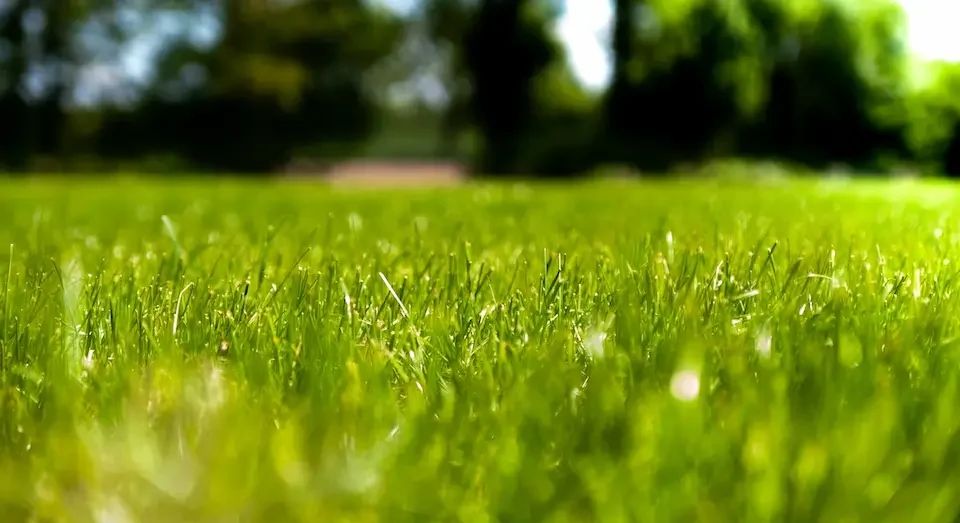How to Plant Grass Seed in NC: A Complete Guide for Growing Cool and Warm Season Grasses
North Carolina’s diverse climate, ranging from the mountains to the coastal plains, creates a unique environment for cultivating different types of grasses. Depending on your location within the state and the specific needs of your lawn, you’ll find that both cool and warm-season grasses can thrive in different parts of North Carolina.
Our Wake Forest lawn care specialists from Turf TitanZ are walking you through the process of planting grass, covering everything from selecting the right grass species for your area to proper soil preparation and ongoing maintenance. Whether you’re aiming for a lush, green lawn during the summer months or a hardy grass that can withstand colder temperatures in the winter, our local landscaping company has your grass seeding needs covered.

Importance of Proper Grass Seed Planting in NC
Proper grass seed planting is of utmost importance when it comes to cultivating a healthy and beautiful lawn in North Carolina.
Climate Adaptability
North Carolina experiences a range of climates, from the cooler mountainous regions to the warmer coastal areas. By selecting the appropriate grass species and following proper planting techniques, you can ensure that your grass seed adapts well to the specific climate conditions of your area.
Disease and Pest Resistance
When the grass is established correctly, it develops a strong root system and dense growth, making it more resilient against common lawn problems such as fungal diseases and insect infestations.
Optimal Germination and Growth
Factors such as seed-to-soil contact, planting depth, and soil preparation all play a significant role in providing the ideal conditions for seed germination. When seeds have adequate contact with the soil and are planted at the correct depth, they can absorb the necessary nutrients and moisture, leading to vigorous growth and a denser, healthier lawn.
Weed Suppression
By promoting a strong and healthy lawn from the beginning, you can minimize weed problems and reduce the need for herbicides or excessive manual weeding.
Aesthetics and Functionality
Whether you’re aiming for a lush, green carpet-like appearance or a turfgrass that can withstand heavy foot traffic, following the correct planting methods ensures consistent growth and an even distribution of grass across your yard.
Benefits of Growing Grass from Seed
Let’s take a closer look at some of the most significant benefits of growing grass from seeds vs laying sod or artificial turf.
Cost-Effectiveness
Growing grass from seed is typically more budget-friendly compared to other methods such as sodding or laying turf.
Variety Selection
Planting grass from seed gives you a wide range of grass species and varieties to choose from, allowing you to select the type that best suits your specific lawn needs and aesthetic preferences.
Adaptability
Grass seeds can be tailored to suit different climate conditions, making it possible to grow grass varieties that thrive in your specific region.
Strong Root Development
Grass grown from seed develops a robust root system, promoting better nutrient absorption, water retention, and overall plant health.
Customizable Lawn Establishment
Planting grass seeds gives you the flexibility to establish your lawn according to your desired timeframe, whether it’s during the cool or warm season.
Enhanced Soil Structure
Grass seed planting helps improve soil structure by increasing organic matter and reducing soil erosion.
Weed Control
Growing grass from seed allows for proper seed-to-soil contact, resulting in a dense lawn that helps suppress weed growth.
Satisfaction of Nurturing
Watching your grass grow from seed can be a rewarding experience, as you witness the transformation from tiny seeds to a lush and healthy lawn.
Long-Term Durability
Grass grown from seed has the potential to establish a durable and long-lasting lawn with proper care and maintenance.
Understanding Cool Season Grasses
When it comes to cultivating a lush and vibrant lawn in North Carolina, it’s crucial to have a good understanding of the grass species that thrive in the region’s climate as well as the best plant types for your lawn.
Characteristics of Cool Season Grasses
Cool-season grasses are known for their ability to grow actively during the cooler months of the year, typically lawn care in spring and fall when temperatures are between 60-75°F (15-24°C).
Cool season grasses have several distinct characteristics, such as:
- A fine texture, which gives lawns a softer and more elegant appearance.
- Deep-root establishing systems allow them to tolerate drought conditions better than warm-season grasses.
- The need for frequent mowing and higher maintenance compared to warm season grasses.
Popular Cool Season Grass Varieties Suitable for NC
Some popular options of cool season grasses commonly found in NC include:
- Kentucky Bluegrass
- Tall Fescue
- Fine Fescue
Best Time to Plant Cool Season Grasses in NC
The ideal time to plant cool-season grasses in NC is during the fall season. The cooler temperatures and increased rainfall create optimal conditions for seed germination and establishment.
Exploring Warm Season Grasses for NC
In addition to cool-season grasses, warm-season grasses are another viable option for homeowners in North Carolina.
Characteristics of Warm Season Grasses
Warm-season grasses are well adapted to the hot and humid summers of North Carolina. They have a higher tolerance for drought conditions and tend to go dormant during the cooler months.
Warm-season grasses exhibit certain characteristics that make them suitable for NC lawns, including:
- A coarse texture, which provides durability and resilience against heavy foot traffic.
- Deep root systems establish an environment for access to water from deeper soil layers.
- Less frequent needs for mowing, as they generally have lower maintenance needs compared to cool season grasses.
Recommended Warm-Season Grass Varieties for North Carolina
Here are some popular warm grass options for NC homeowners:
- Bermuda Grass
- Zoysia Grass
- Centipede Grass
Ideal Planting Time for Warm Season Grasses in NC
The optimal time to plant warm-season grasses in North Carolina is during late spring to early summer. This allows the grass seed to take advantage of the warm soil temperatures and ample sunlight for proper germination and establishment.
Preparing the Soil for Grass Seed Planting
Before planting grass seed, proper soil preparation is essential to create a favorable environment for seed germination and healthy root development.

Assessing Soil Conditions
It’s crucial to assess your soil’s composition and quality before planting grass seed:
- Test the soil pH level using a soil testing kit– most grasses prefer a slightly acidic pH range of 6.0 to 7.0.
- Evaluate the texture and structure of the soil– ideal soil for grass seed planting is well-draining and loamy, with a good balance of sand, silt, and clay particles.
- Check for soil compaction, which hinders root growth and water penetration– compacted soil should be aerated before seeding.
Proper Soil Preparation Techniques for Cool and Warm Season Grasses
To loosen the soil for cool season grasses, use a garden tiller or a hand tool, like a garden fork or spade, to loosen the top 4-6 inches of soil. Remove any rocks, debris, or existing vegetation. When planting warm-season grasses, understand that they require slightly deeper soil preparation, so loosen the top 6-8 inches of soil, breaking up any compacted areas.
Incorporate organic matter, such as compost or well-rotted manure, into the soil to improve its structure, nutrient content, and moisture-holding capacity. Spread a layer of organic matter (about 1-2 inches) and work it into the loosened soil.
After incorporating amendments, use a garden rake to smooth and level the soil surface. Remove any large clumps or debris to provide a consistent planting bed.
Ensuring Proper Drainage for Healthy Root Development
Good soil drainage is crucial for healthy root development and overall plant health.
To improve drainage, consider the following:
- Create a slight slope in your lawn to facilitate water runoff.
- Ensure that areas prone to compaction, such as heavy foot traffic areas or vehicle paths, are adequately addressed through soil aeration and amendment.
- In poorly drained areas, you may need to install subsurface drainage systems, such as French drains, to prevent waterlogging.
Caring for Newly Planted Grass Seed
After planting grass seed, proper care is essential to ensure successful germination and establishment.
The Germination Process and Timeline
The timeline for germination varies depending on the grass species and environmental conditions. Generally, cool-season grasses germinate within 7 to 21 days, while warm-season grasses can take anywhere from 7 to 30 days.
Regular Watering and Proper Irrigation Techniques
Follow these guidelines for watering:
- Water the newly planted grass seed lightly but frequently to keep the top inch of soil moist.
- Avoid overwatering, which can lead to poor germination or fungal issues.
- Water daily or as needed to prevent the soil from drying out.
- Water evenly to prevent pooling or runoff.
- As the grass seedlings start to establish, gradually reduce the frequency of watering while increasing the amount of water applied to encourage deep root growth.
Mowing Guidelines
Follow these mowing guidelines:
- Wait for proper growth
- Adjust mower height
- Avoid removing more than one-third of the grass blade length in a single mowing.
- Use sharp mower blades
Weed Control Strategies
Here are some strategies to control weeds without harming the new grass:
- Hand-pulling
- Mulching
- Pre-emergent herbicides
- Post-emergent herbicides
How to Plant Grass Seed FAQs
Can I plant cool-season grass seed in the summer?
It is generally not recommended to plant cool-season grass seed in the summer in North Carolina. It is best to plant cool-season grass seed in the fall for optimal growth.
What is the easiest grass to grow in North Carolina?
Tall Fescue is often considered the easiest grass to grow in North Carolina. It has good adaptability to a range of soil types, tolerates both sun and shade and has good drought tolerance.
When should I fertilize and seed my lawn in North Carolina?
For cool-season grasses, the best time to fertilize and seed your lawn in North Carolina is during the fall, specifically in September or early October.
How late can you plant grass in NC?
The ideal time to plant grass in North Carolina is typically in the fall. However, depending on the specific grass species and weather conditions, you may be able to plant grass as late as early spring.
Turf TitanZ makes it Simple to Achieve a Lush and Green Lawn All Year Round. Contact Us Today For A Complementary Lawn Seeding Consultation
Don’t settle for a lackluster lawn when you can have a lush and green oasis right at your doorstep. At Turf TitanZ, our lawn seeding experts specialize in making your lawn dreams a reality. Our team of experts is ready to guide you through the process of achieving a vibrant and healthy lawn that will be the envy of your neighborhood.
To contact us for a free grass seeding consultation, call us at (919) 562-0771.
